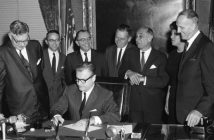Working women have helped shape the U.S. labor movement through playing a key role in organizing workers and leading fights for better wages, health care and safer workplaces, yet their stories are not always widely told.
As we celebrate Women’s History Month, here are a few of the ways that working women have helped advance the labor movement.
As the labor movement began in the early 19th century, women had very few rights and work opportunities outside the home. Early labor unions were often separated by gender and race.
One of the first known women’s labor unions was the United Tailoresses of New York, which formed around 1825. Their work in protesting unfair pay and poor working conditions helped bring public attention to the plight of textile and clothing industry workers.
In the 1840s, women employed at the textile mills in Lowell, Mass., known as the Lowell Female Labor Reform Association and led by Sarah Bagley, was one of the first groups of working women in U.S. history to organize, go on strike and engage in political action to fight for safer working conditions and defeat an anti-labor state representative.
While their work resulted in a limited victory, the Lowell workers showed a timeless lesson that holds true today – when working people stand together and use their collective voices, they can win fights.
Picking up steam
After the Civil War, women increased their momentum in a growing labor movement as they formed unions, including Kate Mullany, who formed the Collar Laundry Union in Troy, N.Y.
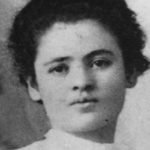
Lemlich
Meanwhile, Black women also stood strong for fair wages and better working conditions, including organizing and holding strikes in Mississippi in 1866 and Atlanta in 1881.
As the 20th century began, the International Ladies Garment Workers Union, which included leaders such as Clara Lemlich and Rose Schneiderman, stood strong to improve sweatshop conditions at garment factories in the early 1900s.
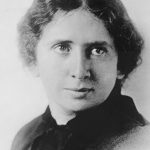
Schneiderman
The union held strikes at several factories in 1909 and 1910, but it took a tragedy to raise awareness.
Following the March 1911 fire at the Triangle Shirtwaist Factory that killed 146 people, the public demanded changes in laws and workplace safety.
One fire eyewitness made it a catalyst for her life’s work. Frances Perkins, who later became the first woman to serve in a presidential cabinet as President

Perkins
Franklin D. Roosevelt’s Secretary of Labor, was key to passing state legislation that put into place workplace safety measures and shorter workdays.
Fighting for suffrage
New York state was central to many pivotal moments in women’s suffrage. The suffrage movement dawned during the first-ever Women’s Rights Convention in
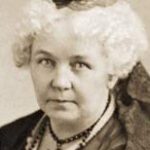
Stanton
Seneca Falls in 1848, when Elizabeth Cady Stanton introduced a resolution to fight for voting rights.
The movement grew more intense later in the 19th century, partially due to the efforts of Susan B. Anthony, who worked with Stanton to fight for a U.S. Constitutional amendment to grant suffrage to all. Anthony was notably arrested in Rochester and later convicted for voting in the 1872 Presidential election.
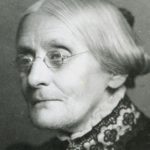
Anthony
Labor union women also became key to the suffrage movement, teaming up with suffragists to win justice. Suffragist leaders not only recruited working women into their ongoing fight to win the right to vote, but adopted some of the same activism tactics commonly used by unions, including demonstrations and political action. Many suffragists faced violence, torture and imprisonment for their cause. While the 19th Amendment was ratified in 1920 and constitutionally gave women the right to vote, many women of color could not freely exercise that right until the Voting Rights Act was enacted in 1965. Even today, many people still struggle to exercise their voting rights.
Greater roles
In 1912, textile workers in Lawrence, Mass. walked off the job in what became known as the “Bread and Roses Strike.” Women played a major role in the strike, also known to be one of the first major labor events that stretched across gender and ethnic lines.
While it is widely known that millions of women worked during World War II in industrial, agriculture, transportation and public service jobs to replace men who had gone to war, women had also done so when the United States entered World War I in 1917.

Jones
The Great Depression brought a strong increase in union organizing, as well as New Deal era legislation that included the Fair Labor Standards Act that established the minimum wage and limits on workdays. Perkins helped establish and implement New Deal reforms, many of which remain in place.
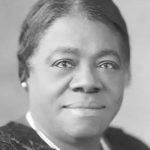
Bethune
Black women also continued fighting for justice during the 1930s, including Dora Lee Jones who helped establish the Domestic Workers’ Union in 1934. The following year, Mary McLeod Bethune organized a coalition of Black women’s groups that lobbied against job discrimination, racism, and sexism. She later advised President Franklin D. Roosevelt, the first Black woman to ever serve in such a role.
Progress and struggle
While the latter half of the 20th century saw legislation ending discrimination on several fronts, women still struggled to get equal pay, better working conditions, increased career opportunities and full inclusion. Women continue to play leading roles in labor issues in recent decades.
Despite the shattering of many glass ceilings in the 21st century, working women are still struggling for equality. In 2023, women make 83 cents to every dollar that white men make, and the pay gap is even greater for Black and Latina women. Labor union women make about 23% more than their nonunion counterparts and have greater pay equity, health benefits and safer working conditions.
The pandemic also spurred workers in numerous industries to form unions, including food service, retail, media, call centers and cultural organizations. Cornell University reports that about 60% of workers who have organized over the past decade are women, and women are key to leading many of these campaigns.



